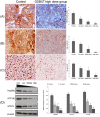A systems biology-based investigation into the therapeutic effects of Gansui Banxia Tang on reversing the imbalanced network of hepatocellular carcinoma
- PMID: 24561634
- PMCID: PMC3932480
- DOI: 10.1038/srep04154
A systems biology-based investigation into the therapeutic effects of Gansui Banxia Tang on reversing the imbalanced network of hepatocellular carcinoma
Erratum in
-
Author Correction: A systems biology-based investigation into the therapeutic effects of Gansui Banxia Tang on reversing the imbalanced network of hepatocellular carcinoma.Sci Rep. 2022 Nov 4;12(1):18671. doi: 10.1038/s41598-022-22833-6. Sci Rep. 2022. PMID: 36333372 Free PMC article. No abstract available.
Abstract
Several complex molecular events are involved in tumorigenesis of hepatocellular carcinoma (HCC). The interactions of these molecules may constitute the HCC imbalanced network. Gansui Banxia Tang (GSBXT), as a classic Chinese herbal formula, is a popular complementary and alternative medicine modality for treating HCC. In order to investigate the therapeutic effects and the pharmacological mechanisms of GSBXT on reversing HCC imbalanced network, we in the current study developed a comprehensive systems approach of integrating disease-specific and drug-specific networks, and successfully revealed the relationships of the ingredients in GSBXT with their putative targets, and with HCC significant molecules and HCC related pathway systems for the first time. Meanwhile, further experimental validation also demonstrated the preventive effects of GSBXT on tumor growth in mice and its regulatory effects on potential targets.
Figures





Similar articles
-
Identifying Antihepatocellular Carcinoma Compounds in Gansui Banxia Decoction Using Live Cell Adsorption.Drug Des Devel Ther. 2025 Apr 29;19:3437-3457. doi: 10.2147/DDDT.S513086. eCollection 2025. Drug Des Devel Ther. 2025. PMID: 40322038 Free PMC article.
-
Identification of the molecular targets and mechanisms of compound mylabris capsules for hepatocellular carcinoma treatment through network pharmacology and bioinformatics analysis.J Ethnopharmacol. 2021 Aug 10;276:114174. doi: 10.1016/j.jep.2021.114174. Epub 2021 Apr 29. J Ethnopharmacol. 2021. PMID: 33932512
-
Exploring the Molecular Mechanisms of Huaier on Modulating Metabolic Reprogramming of Hepatocellular Carcinoma: A Study based on Network Pharmacology, Molecular Docking and Bioinformatics.Curr Pharm Des. 2024;30(24):1894-1911. doi: 10.2174/0113816128287535240429043610. Curr Pharm Des. 2024. PMID: 38747231
-
Preventive and Therapeutic Effects of Chinese Herbal Compounds against Hepatocellular Carcinoma.Molecules. 2016 Jan 27;21(2):142. doi: 10.3390/molecules21020142. Molecules. 2016. PMID: 26828466 Free PMC article. Review.
-
Chinese herbal medicine-derived compounds for cancer therapy: a focus on hepatocellular carcinoma.J Ethnopharmacol. 2013 Oct 7;149(3):601-12. doi: 10.1016/j.jep.2013.07.030. Epub 2013 Aug 1. J Ethnopharmacol. 2013. PMID: 23916858 Review.
Cited by
-
A bioinformatics investigation into the pharmacological mechanisms of the effect of Fufang Danshen on pain based on methodologies of network pharmacology.Sci Rep. 2019 Apr 11;9(1):5913. doi: 10.1038/s41598-019-40694-4. Sci Rep. 2019. PMID: 30976033 Free PMC article.
-
Can network pharmacology identify the anti-virus and anti- inflammatory activities of Shuanghuanglian oral liquid used in Chinese medicine for respiratory tract infection?Eur J Integr Med. 2020 Aug;37:101139. doi: 10.1016/j.eujim.2020.101139. Epub 2020 May 26. Eur J Integr Med. 2020. PMID: 32501408 Free PMC article.
-
A Network Pharmacology Approach to Explore the Pharmacological Mechanism of Xiaoyao Powder on Anovulatory Infertility.Evid Based Complement Alternat Med. 2016;2016:2960372. doi: 10.1155/2016/2960372. Epub 2016 Dec 18. Evid Based Complement Alternat Med. 2016. PMID: 28074099 Free PMC article.
-
Identifying Antihepatocellular Carcinoma Compounds in Gansui Banxia Decoction Using Live Cell Adsorption.Drug Des Devel Ther. 2025 Apr 29;19:3437-3457. doi: 10.2147/DDDT.S513086. eCollection 2025. Drug Des Devel Ther. 2025. PMID: 40322038 Free PMC article.
-
Systematic investigation of transcription factors critical in the protection against cerebral ischemia by Danhong injection.Sci Rep. 2016 Jul 19;6:29823. doi: 10.1038/srep29823. Sci Rep. 2016. PMID: 27431009 Free PMC article.
References
-
- Parkin D. M. et al. Global cancer statistics, 2002. CA Cancer J. Clin. 55, 74–108 (2005). - PubMed
-
- Sherman M. Recurrence of hepatocellular carcinoma. N. Engl. J. Med. 359, 2045–2047 (2008). - PubMed
-
- Thorgeirsson S. S. & Grisham J. W. Molecular pathogenesis of human hepatocellular carcinoma. Nat. Genet. 31, 339–346 (2002). - PubMed
-
- Forner A., Llovet J. M. & Bruix J. Hepatocellular carcinoma. Lancet. 379, 1245–1255 (2012). - PubMed
Publication types
MeSH terms
Substances
LinkOut - more resources
Full Text Sources
Other Literature Sources
Medical

